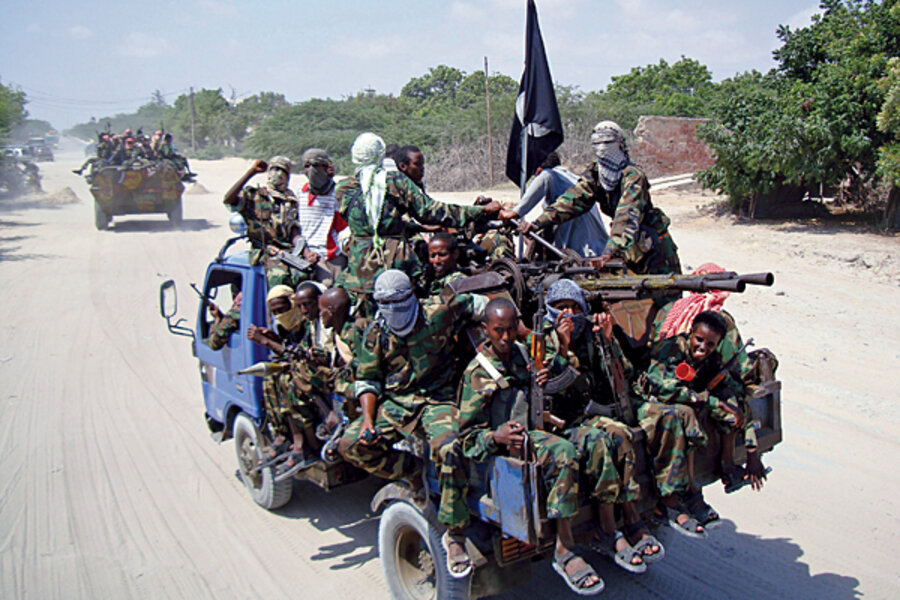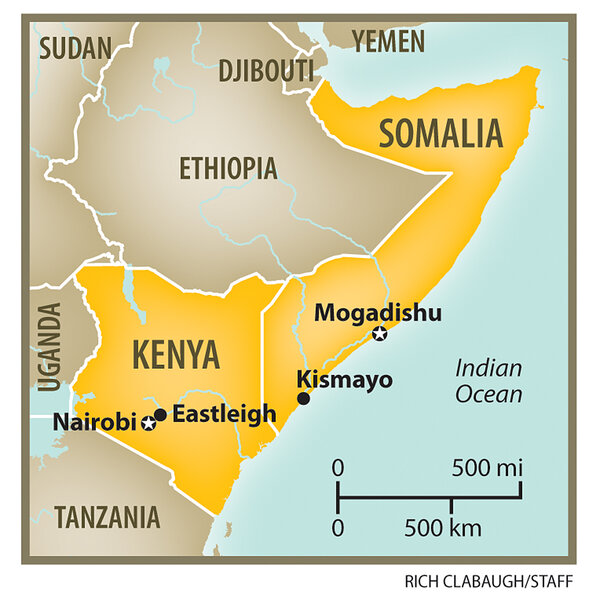Inside Al Shabab: How the Somalia militant group rules through fear
Loading...
| Nairobi, Kenya
On Oct. 27, 2008, Ali Abdullahi Egal saw the Al Qaeda-linked militant group Al Shabab stone to death a 13-year-old girl, Aisha Duhulow, under the charge of adultery. The act was not only brutal, but also, in his view, un-Islamic.
The girl had apparently been raped, was not given the right to a legal advocate, and Al Shabab didn’t even bother to produce four eyewitnesses before declaring her guilty.
When Mr. Egal, a human rights activist, reported this event to local and international news organizations two days later, it produced an outcry, and helped set in stone Al Shabab’s image as a cruel and totalitarian regime in control of large portions of southern Somalia. Within a day, Egal received his first death threat, and then his second.
“They called me on the telephone and threatened me,” says Egal, now living in a variety of safe houses in neighboring Kenya. “They said, ‘You are working with the kaffir [unbelievers], you work for the CIA and Israeli intelligence.’ ”
Later, when he reached Kenya, he received a chilling e-mail:
“We have noted that you escaped from us and fled from Kismayo. After that we realized that your family also moved from the village in order to run off from us but you are being awaited in any of the refugee camps in Kenya and you will not survive. Even if you reach Nairobi, it will not help you as you were sentenced to death. Therefore, the Islamic fighters will retaliate against you and you will not know which date it is.”
The e-mail was signed by the senior Al Shabab leader of Kismayo, Sheikh A.G.Y. Abu Hamza.
After two years, Al Shabab’s hold over the port city of Kismayo and much of southern Somalia has only strengthened, and its threat to the Western-backed Somali government in Mogadishu is matched only by its brutal treatment to those Somalis it sees as enemies.
Some of the heaviest fighting of the year erupted last week in Mogadishu as militants advanced on government-held territory, killing more than 50 people and sending hundreds fleeing. Some 3.7 million Somalis – nearly half of the population – already need aid. Fighting continued into this week, with the government struggling to hold the capital with the help of more than 6,000 African Union peacekeepers.
Since 2007, at least nine Somali journalists have been killed by Al Shabab, while dozens of others have fled Al Shabab-controlled areas after repeated death threats. Harsh sentences for criminals – amputation for thieves, stoning for adulterers, decapitation for various other enemies – have become public events in football stadiums, scenes reminiscent of when the Taliban controlled Afghanistan.
A government pushback?
But the coming months may see a change, if not in the power balance in Somalia, then at least in the level of violence, as thousands of freshly trained Somali troops return from Ethiopia, Kenya, Djibouti, and Uganda to take up positions with the weak Transitional Federal Government in Mogadishu.
These troops have also been joined by recently mobilized militias of an anti-Al Shabab religious society called Ahlu Sunna Wal Jamaa, which has opened up new fronts against Al Shabab and its allied Islamist militia, Hizbul Islam. Ahlu Sunna Wal Jamaa's powerful militia signed a formal agreement on Monday with the UN-backed government to offer ground support in exchange for senior government positions.
In Mogadishu, officials loyal to President Sheikh Sharif Ahmed talk openly about a coming government offensive against Al Shabab. Already the number of attacks between the two factions has increased, with reports of hundreds of Al Shabab fighters from Kismayo – led by Alabama-born commander Abu Mansour al-Amriki – to reinforce the front lines of Mogadishu, while tens of thousands of Somalis moved in the opposite direction, seeking safety in displacement camps.
‘I dream that they will kill me’
For Egal, however, such displacement or refugee camps offer no safety. His wife, children, and parents have gone into hiding far from Kismayo, and he hasn’t heard from them for months. He has received refugee status from the United Nations, and has applied for political asylum – like some 18,600 other Somalis – to live in another country. He has also been offered shelter inside a protected UN facility, but Egal refuses to enter it, worried that he might be spotted there by an Al Shabab sympathizer among the other residents.
“I have no work, no relations to give me support,” he says. “I don’t sleep in any one place more than once. Every night, I dream that they will kill me.”
Egal’s caution is understandable, even in Nairobi. In the Somali-dominated neighborhood of Eastleigh, the majority of residents are either Somalis of Kenyan nationality or refugees who fled the war. But the number of radical mosques that support Al Shabab is growing, and at Friday afternoon prayers, sermons extolling support for Al Shabab’s social revolution in Somalia can be heard blaring from mosque loudspeakers.
While Egal stays in hiding, he still harbors a grudge against Al Shabab and the foreign militants who increasingly come to Somalia to carry out their own idea of jihad.
“People are coming from other countries like America and Britain and the Arab countries to fight jihad against the unbelievers, but this is a country full of Muslims,” he says, incredulous. “If they want jihad, why don’t they do it in their own country? Why do they want to destroy my country and kill my children?”






